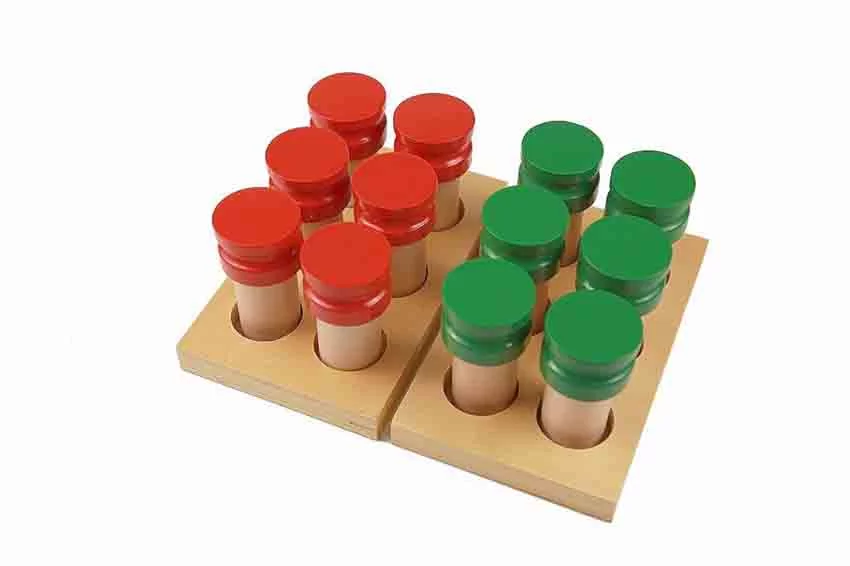This sensorial lesson is designed for 3-6 year old children to introduce them with different smells and stimulate their olfactory sense.
Montessori education always encourages children to learn through hands-on experiences, stimulating their senses to explore and engage with the world. Smelling bottles, a key part of Montessori sensorial education, allow children to discover the power of scent. This activity refines their olfactory senses, helps with memory development, and promotes a deeper awareness of their environment.
What Are Montessori Smelling Bottles?
Montessori smelling bottles are small, opaque or tinted containers filled with cotton balls or sponges infused with different scents. These scents can be natural, such as lavender, citrus, or cinnamon, or familiar smells from the child’s daily environment. The activity involves two sets of identical bottles, where the objective is for children to smell and match the pairs by recognising the scents. This exercise strengthens their sensory perception and helps develop mental focus, observation skills, and a sense of independence.
The bottles are designed to be neutral on the outside to ensure children concentrate solely on the scents, training them to isolate and differentiate smells without relying on visual cues.
What is the Importance of Smelling Bottles in Montessori Education?
Montessori smelling bottles offer several benefits that align with the Montessori philosophy of sensory learning. Here’s why this activity holds significant importance:
- Refinement of the Olfactory Sense
Smelling bottles sharpen the child’s ability to identify, compare, and match scents, contributing to the development of their olfactory senses. - Memory and Cognitive Development
The act of associating scents with specific memories or experiences enhances memory retention and cognitive skills. Children learn to make mental connections between smells and familiar environments, promoting their ability to recognise and recall scents over time. - Enhanced Focus and Concentration
Since the child must pay close attention to the scents to correctly match the bottles, the activity strengthens their ability to focus and remain patient. - Language Development
Introducing new smells encourages children to learn descriptive vocabulary, such as “spicy,” “sweet,” “earthy,” or “citrus,” helping expand their language skills. - Mindfulness and Awareness
By focusing on their sense of smell, children learn to be more mindful and aware of their surroundings, fostering a sense of calm and grounding. - Encouragement of Independence
The Montessori approach promotes self-directed learning. Through smelling bottles, children explore, make observations, and correct mistakes independently, which builds their confidence and autonomy.
What Kinds of Smells Can Be Used in Smelling Bottles?
The scents used in Montessori smelling bottles are carefully chosen to offer a range of sensory experiences. Some examples include:
- Floral Scents
- Lavender
- Rose
- Jasmine
- Fruity Scents
- Lemon
- Orange
- Pineapple
- Spices and Herbs
- Cinnamon
- Mint
- Cloves
- Earthy or Natural Scents
- Pine
- Eucalyptus
- Sandalwood
- Food-Based Scents
- Vanilla
- Coffee
- Chocolate
These scents can be tailored based on the child’s environment, preferences, or even seasons. Familiar smells evoke curiosity and help children connect with the activity, while new scents introduce an element of discovery.
Presentation: Step-by-Step Guide
- Invite the Child
Ask the child if they would like to explore the smelling bottles activity. - Introduce the Materials
Place the two sets of bottles on a tray and explain, “We are going to match these bottles by using only our noses to smell the scents.” - Demonstrate the Process
Take one bottle from the first set, open it, and bring it close to your nose. Smell it deeply and say aloud, “I smell lavender.” Invite the child to smell the same bottle and share what they think. - Find the Matching Bottle
Open a bottle from the second set and smell it. If it matches, place both bottles together, saying, “These two smell the same!” If it doesn’t match, keep searching until the correct pair is found. - Continue Matching
Encourage the child to match all the bottles by smelling and pairing the identical scents.
Control of Error
In Montessori activities, the control of error allows children to identify and correct their own mistakes. For smelling bottles, children will notice if the scents do not match, prompting them to try again until they find the correct pair. This feature helps develop problem-solving skills and promotes independent learning.
Variations and Extensions
The smelling bottles activity can be adapted to introduce new challenges and keep children engaged. Here are some ways to extend the lesson:
- Blindfold Matching
- For an extra challenge, blindfold the child and ask them to match the bottles using only their sense of smell.
- This variation strengthens concentration by eliminating visual cues and makes the activity more engaging.
- Seasonal Scents
- Introduce scents associated with different seasons, such as peppermint for winter or fresh-cut grass for summer.
- This approach helps children connect smells with specific times of the year.
- Guess the Scent Game
- Present bottles with new scents and ask the child to guess what they smell.
- Encourage them to describe the scent in their own words, helping develop language and sensory awareness.
- Storytelling with Scents
- Use the scents to inspire a storytelling session. For example, a cinnamon scent could lead to a discussion about baking or holidays.
- This variation encourages imagination and creative thinking.
- Mix and Match
- Add a third set of bottles with complementary scents, such as lemon and mint.
- Challenge the child to find pairs that work well together, fostering critical thinking.
Purpose of the Activity
- Direct Aim: To refine the child’s olfactory sense and enhance their ability to identify and distinguish between different smells.
- Indirect Aim: To improve concentration, develop memory, build vocabulary, and foster independence.
Conclusion
The Montessori smelling bottles activity offers a rich, sensory experience that goes beyond simple scent recognition. It engages children in meaningful exploration, fostering cognitive development, mindfulness, and a deeper connection with their surroundings. By introducing them to a wide range of scents, the activity encourages curiosity and builds important life skills like concentration, observation, and independent problem-solving.
With various possibilities for extension, the smelling bottles lesson remains dynamic and adaptable, ensuring children stay engaged and continue to enjoy the wonders of sensory exploration.

